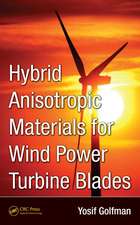Introduction to the mechanics of plastic forming of metals: Mechanics of Plastic Solids, cartea 3
Autor W. Szczepinskien Limba Engleză Paperback – 10 noi 2011
Preț: 392.21 lei
Nou
Puncte Express: 588
Preț estimativ în valută:
75.05€ • 78.57$ • 62.10£
75.05€ • 78.57$ • 62.10£
Carte tipărită la comandă
Livrare economică 08-22 aprilie
Preluare comenzi: 021 569.72.76
Specificații
ISBN-13: 9789400995499
ISBN-10: 9400995490
Pagini: 384
Ilustrații: 378 p.
Dimensiuni: 152 x 229 x 20 mm
Greutate: 0.51 kg
Ediția:Softcover reprint of the original 1st ed. 1979
Editura: SPRINGER NETHERLANDS
Colecția Springer
Seria Mechanics of Plastic Solids
Locul publicării:Dordrecht, Netherlands
ISBN-10: 9400995490
Pagini: 384
Ilustrații: 378 p.
Dimensiuni: 152 x 229 x 20 mm
Greutate: 0.51 kg
Ediția:Softcover reprint of the original 1st ed. 1979
Editura: SPRINGER NETHERLANDS
Colecția Springer
Seria Mechanics of Plastic Solids
Locul publicării:Dordrecht, Netherlands
Public țintă
ResearchCuprins
1. Mechanical Properties of Metals.- 1.1 The plastic behaviour of metals.- 1.2 Effect of strain rate on resistance of metals to deformation.- 1.3 Idealized stress-strain curves.- 2. Stresses, Strains and Flow Velocities.- 2.1 The state of strass.- 2.2 The state of strain.- 2.3 Strain rates.- 2.4 Equations of motion and equations of equilibrium.- 3. Yield Conditions and Flow Laws.- 3.1 General remarks.- 3.2 Huber-Mises yield condition.- 3.3 Tresca yield condition.- 3.4 Experimental verification of the yield condition.- 3.5 Effect of plastic deformation on yield condition.- 3.6 Strain-hardening hypotheses.- 3.7 Stress-strain rate relations.- 3.8 Drucker’s postulate; convexity of the yield surface.- 3.9 Extremum principles of plasticity.- 3.10 Brief summary; equations of the three-dimensional plastic flow.- 4. The Theory of Plane Plastic Flow.- 4.1 Basic relations.- 4.2 Determination of the stress field.- 4.3 Properties of slip-lines.- 4.4 Elementary nets of slip-lines.- 4.5 Basic boundary value problems.- 4.6 Graphical construction of slip-line nets.- 4.7 Determination of the velocity field.- 4.8 Stress and velocity discontinuities.- 4.9 The velocity hodograph.- 4.10 The condition of non-negative rate of internal energy dissipation.- 5. Indentation and Compression Operations.- 5.1 Introduction.- 5.2 Indentation of a flat punch into a half-space.- 5.3 Indentation of a plastic block by two opposite narrow punches.- 5.4 Compression of a plastic block between two flat rough plates.- 5.5 Compression of a block between partially rough plates.- 5.6 Wedge indentation.- 5.7 Cutting of a strip with a knife-edged tool.- 5.8 Compression of a plastic wedge by a flat plate.- 6. Two-Dimensional Steady-State Operations.- 6.1 General remarks.- 6.2 Sheet drawing through a smoothwedge-shaped die.- 6.3 Drawing through a rough die.- 6.4 Sheet drawing with small reduction in thickness.- 6.5 Dynamic effects in sheet drawing.- 6.6 Drawing through a curvilinear die.- 6.7 Extrusion operations.- 6.8 Piercing.- 7. Some Two-Dimensional Non-Steady State Operations.- 7.1 Introduction.- 7.2 Press forging in dies.- 7.3 Combined extrusion and piercing.- 8. Axially Symmetric Plastic Flow.- 8.1 Introduction.- 8.2 Basic relations.- 8.3 Determination of stresses.- 8.4 Determination of velocities.- 8.5 Indentation of a plastic half-space by a flat circular punch.- 8.6 Indentation of a rigid cone. Rockwell hardness test.- 8.7 Compression and press forging of axially symmetric elements.- 8.8 Special problems in axially symmetric flow.- 9. Plane Stress.- 9.1 General relations.- 9.2 Solution of plane stress equations for the Huber-Mises yield condition.- 9.3 Velocity field associated with the Huber-Mises yield condition.- 9.4 Velocity discontinuities.- 9.5 Solution of plane stress equations under the Tresca yield condition.- 9.6 Plane stress problems under axial symmetry.- 9.7 Plastic deformation of flat rings.- 9.8 Strain-hardening solutions of axially symmetric plane stress problems.- 9.9 Drawing of cups from circular blanks.- 10. Axially Symmetric Problems of Plastic Forming of Shells under Conditions of Plane Stress.- 10.1 Introduction.- 10.2 The steady-state forming operations.- 10.3 Dynamic solution to the tube drawing.- 10.4 Non-stationary forming operations.- 10.5 Non-stationary process as the final stage of a stationary process.- 10.6 The passage from non-stationary to stationary stage of the process.- 11. Drawing and Stretchforming of Thin-Walled Shells of Arbitrary Double Curvature.- 11.1 Introduction.- 11.2 Basic relations.- 11.3 Characteristics of the stress field for the Huber-Mises yield criterion.- 11.4 Characteristics of the velocity field associated with the Huber-Mises yield criterion.- 11.5 Characteristics of the stress field for the Tresca yield criterion.- 11.6 Characteristics of the velocity field associated with the Tresca yield condition.- 11.7 Stretchforming of thin-walled shells.- 11.8 Drawing through a die, Huber-Mises yield condition.- 11.9 Drawing through a die, Tresca yield condition.- 11.10 Drawing through a die, influence of the friction on the die-sheet interface.- Appendix 1.- Appendix 2.- References.- Supplementary references.- Author index.


















